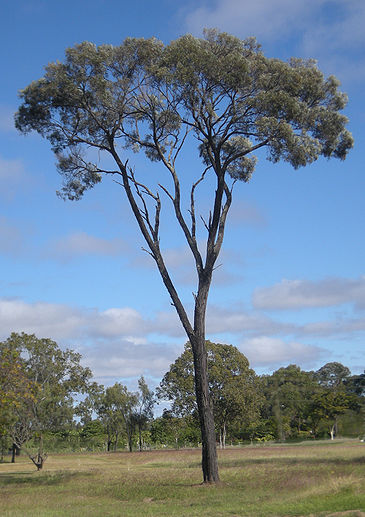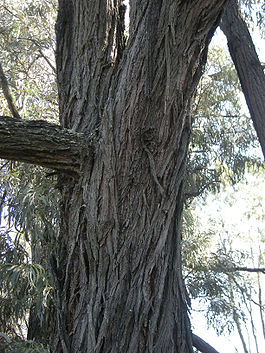
Acacia harpophylla
Encyclopedia
Acacia harpophylla, commonly known as the Brigalow , Brigalow Spearwood or Orkor is an endemic
tree of Australia
. It is found in central and coastal Queensland
to northern New South Wales
. It can reach up to 25 meters tall and forms extensive open-forest communities on clay soils.

 Two species, brigalow (A. harpophylla) and gidgee (A. cambagei
Two species, brigalow (A. harpophylla) and gidgee (A. cambagei
) form open woodlands on flat and gently undulating terrain on heavy and relatively fertile clay and clay-loam soils primarily in the 300-700mm annual rainfall region of Eastern Australia. These woodlands extend from a northern extreme of 20o S into northern New South Wales. Brigalow and gidgee occur as mixed communities in some regions and are commonly associated with several other woody species, including overstorey species such as Eucalyptus coolabah
, E. cambageana
, Casuarina cristata, and a range of understorey species. A. tephrina, A. georginae
and A. argyrodendron also occupy similar habitats and have similar habits and growth forms, but are less widespread, while a number of other Acacia species also form structurally similar communities
Brigalow occurs from coastal regions receiving in excess of 900mm rainfall per year through to the semi arid 500mm rainfall region although it is primarily a semi-arid zone species. Gidgee (A. cambagei) replaces brigalow as rainfall drops in western regions and extends from 650mm-300mm. Gidgee, with a maximum height of approximately 12 metres is somewhat smaller than brigalow which can attain heights of 20 metres. In the north-western regions Black gidgee (A. argyrodendron) replaces brigalow in many areas, while in Central-Western districts Boree (A. tephrina) forms woodlands and shrublands, frequently on cracking clay soils and often in association with A. cambagei. Georgina gidgee (A. georginae) woodlands are found in more arid regions in the 200-250mm rainfall belt.
Species associated with these brigalow communities generally have a good capacity for re-sprouting following fire, and brigalow itself sprouts freely from the butt, roots and living stems in response to fire damage. Both gidgee and blackwood, in contrast, have a limited capacity to resprout following fire damage. A notable exception to the fire tolerance of brigalow communities occurs in what are referred to as softwood scrubs, which are dense communities of brigalow and a range of particularly fire-sensitive species. Fire in any brigalow or gidgee woodland would be a rare event under natural circumstances, since pasture is at best sparse in these communities, consisting of Chloris
, Paspalidium
, Dicanthium, Sporobolus
and Eragrostis species.
Endemic (ecology)
Endemism is the ecological state of being unique to a defined geographic location, such as an island, nation or other defined zone, or habitat type; organisms that are indigenous to a place are not endemic to it if they are also found elsewhere. For example, all species of lemur are endemic to the...
tree of Australia
Australia
Australia , officially the Commonwealth of Australia, is a country in the Southern Hemisphere comprising the mainland of the Australian continent, the island of Tasmania, and numerous smaller islands in the Indian and Pacific Oceans. It is the world's sixth-largest country by total area...
. It is found in central and coastal Queensland
Queensland
Queensland is a state of Australia, occupying the north-eastern section of the mainland continent. It is bordered by the Northern Territory, South Australia and New South Wales to the west, south-west and south respectively. To the east, Queensland is bordered by the Coral Sea and Pacific Ocean...
to northern New South Wales
New South Wales
New South Wales is a state of :Australia, located in the east of the country. It is bordered by Queensland, Victoria and South Australia to the north, south and west respectively. To the east, the state is bordered by the Tasman Sea, which forms part of the Pacific Ocean. New South Wales...
. It can reach up to 25 meters tall and forms extensive open-forest communities on clay soils.


Acacia cambagei
Acacia cambagei, commonly known as Gidgee , Stinking wattle or Stinking gidgee is an endemic tree of Australia. It is found primarily in semi-arid and arid Queensland but extends into the Northern Territory, South Australia and north-western New South Wales. It can reach up to 12 meters in height...
) form open woodlands on flat and gently undulating terrain on heavy and relatively fertile clay and clay-loam soils primarily in the 300-700mm annual rainfall region of Eastern Australia. These woodlands extend from a northern extreme of 20o S into northern New South Wales. Brigalow and gidgee occur as mixed communities in some regions and are commonly associated with several other woody species, including overstorey species such as Eucalyptus coolabah
Eucalyptus coolabah
Eucalyptus coolabah is a eucalypt of riparian zones and is found throughout Australia from arid inland to coastal regions. The plant is commonly called coolibah or coolabah, the name being a loanword from the Indigenous Australian Yuwaaliyaay word, gulabaa.Propagation is dependent on periods of...
, E. cambageana
Eucalyptus cambageana
Eucalyptus cambageana, commonly known as the Dawson River blackbutt, is a species of eucalypt native to eastern Australia....
, Casuarina cristata, and a range of understorey species. A. tephrina, A. georginae
Acacia georginae
Acacia georginae is a perennial tree which is native to Australia and which has been introduced into the United States. Common names for it include Georgina Gidgee, Georgina Gidyea and Poison Gidyea...
and A. argyrodendron also occupy similar habitats and have similar habits and growth forms, but are less widespread, while a number of other Acacia species also form structurally similar communities
Brigalow occurs from coastal regions receiving in excess of 900mm rainfall per year through to the semi arid 500mm rainfall region although it is primarily a semi-arid zone species. Gidgee (A. cambagei) replaces brigalow as rainfall drops in western regions and extends from 650mm-300mm. Gidgee, with a maximum height of approximately 12 metres is somewhat smaller than brigalow which can attain heights of 20 metres. In the north-western regions Black gidgee (A. argyrodendron) replaces brigalow in many areas, while in Central-Western districts Boree (A. tephrina) forms woodlands and shrublands, frequently on cracking clay soils and often in association with A. cambagei. Georgina gidgee (A. georginae) woodlands are found in more arid regions in the 200-250mm rainfall belt.
Species associated with these brigalow communities generally have a good capacity for re-sprouting following fire, and brigalow itself sprouts freely from the butt, roots and living stems in response to fire damage. Both gidgee and blackwood, in contrast, have a limited capacity to resprout following fire damage. A notable exception to the fire tolerance of brigalow communities occurs in what are referred to as softwood scrubs, which are dense communities of brigalow and a range of particularly fire-sensitive species. Fire in any brigalow or gidgee woodland would be a rare event under natural circumstances, since pasture is at best sparse in these communities, consisting of Chloris
Chloris (plant)
Chloris is a genus of grasses which are known generally as windmill grass or finger grass.These grasses are found worldwide, but especially in the tropical and subtropical regions, and more often in the Southern Hemisphere...
, Paspalidium
Paspalidium
Paspalidium is a genus of grass in the Poaceae family.-External links:*...
, Dicanthium, Sporobolus
Sporobolus
Sporobolus is a genus of grasses in the family Poaceae. They are usually called dropseed grasses or sacaton grasses. They are typical prairie and savanna plants, and they occur in other types of open habitat in warmer climates....
and Eragrostis species.

